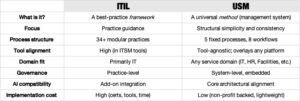A post by our guest editor, John Worthington.
Why a Unified Management System is What the Enterprise Really Needs Now
A recent white paper by GPS17 Consulting presents one of the best-balanced comparisons I’ve seen between ITIL and the Unified Service Management (USM) method. The paper is grounded, pragmatic, and backed by real-world scenarios. If you're navigating the future of ITSM or enterprise services, it's definitely worth a read.
But as someone who’s worked in this field for decades—and now sees firsthand how organizations are struggling with AI, automation, and service fragmentation—I think there's a deeper conversation we need to have.
Let me offer a different lens.
🧠 USM Isn’t an Alternative to ITIL—It’s What Comes Before It
The most important clarification for readers is this:
USM is not a replacement for ITIL, COBIT, ISO 20000, or any other framework. It’s a method—a system architecture that defines how to manage any service, consistently, regardless of domain, tool, or practice.
Where frameworks like ITIL tell you what to do through detailed practices, USM tells you how to manage services using a standardized structure:
- 5 repeatable processes
- 8 universal workflows
- Role-based task assignment
- Clear service specifications and feedback loops
Think of ITIL as a content library—and USM as the operating system that runs it. You don’t need to choose. You need to coordinate.
🤖 Why This Matters More Than Ever: AI, Automation, and ESM
As AI agents, predictive workflows, and low-code automations take over more of our service environments, the cracks in traditional ITSM architectures are starting to show.
Let’s face it: AI doesn’t reduce complexity—it amplifies it. You now have bots making decisions, models adapting to data, and workflows being triggered autonomously. If you don’t have a unified system to manage these interactions, you lose visibility, control, and trust.
Tool-based ITSM solutions, even when ITIL-aligned, weren’t designed for this. They were built to implement practices, not govern systems.
USM is different. It’s a method to manage complexity at the system level—across all services, all roles, and all domains.
🛠️ What About Tooling?
The white paper fairly points out that many ITSM tools (like ServiceNow, Jira, or Freshservice) don't natively support USM. That’s true—but let’s not confuse tool constraints with method limitations.
Most tools are designed around frameworks like ITIL. USM simply asks:
- Can your tool support standardized workflows across domains?
- Can it manage services using a consistent process model, regardless of who or what performs the task?
- Can you automate without fragmenting governance?
If not—maybe it's the tool that needs to evolve.
USM isn’t incompatible with tools—it helps you assess and guide their use. It's the blueprint that helps you simplify, integrate, and automate without turning your toolchain into a spaghetti diagram of practice silos and disconnected bots.
📊 Summary: Frameworks, Tools… or Systems?

🔑 Final Thought: USM is how you manage; ITIL is what you apply.
The phrase “hybrid approach” may unintentionally imply that USM and ITIL are two competing service management models that need to be blended. In reality, USM is a method—a universal management system architecture—not a framework or body of practices like ITIL.
Organizations don’t fail because they lack frameworks. They fail because they lack coherence.
USM gives you that coherence. It enables a repeatable way to manage services, integrate AI, automate with accountability, and scale service excellence beyond IT.
Use USM to establish a consistent system of service governance across all domains (IT, HR, facilities, customer service, etc.). Then apply ITIL practices where they add depth and domain-specific guidance, especially in complex or regulated environments.
This aligns well with the shift toward Enterprise Service Management, where service management is no longer “just IT’s job.” With AI and automation extending across the enterprise, service management is everyone's business—and USM offers the management logic to make that scalable and sustainable.
Happy to continue this discussion—great work putting this together!
📚 PS: A Decade-Old Provocation That Still Resonates
For those interested in the origins of this debate, I’d point you to a thought-provoking article written back in 2014 by USM’s Chief Architect, Jan van Bon, titled “Who Will Beat ITIL?”.
While the title is deliberately provocative (and perhaps unhelpfully so today—USM was never intended to beat ITIL), the core insight remains as relevant now as it was then:
Organizations don’t fail because they choose the wrong framework. They fail because they don’t have a consistent management system to apply and govern those frameworks.
Van Bon’s article anticipated a challenge many are still struggling with today: practice overload without system coherence. And with AI, automation, and cross-domain service demands accelerating, that challenge has only grown more urgent.
So maybe the better question isn’t "Who will beat ITIL?" It’s: "What will make ITIL—and every other framework—finally work?"
My answer: a unified management system. And for that, USM is the method to watch.
🎯 Interested in making this shift? The USM Foundation and Professional Certifications, supported by the non-profit SURVUZ Foundation, are clear, accessible, and cost-effective. And they’ll change how you think about service management forever.
Let’s stop debating frameworks. Let’s start building service systems that work.
==/==
![]() If you enjoyed John's post and it made you think about improving your own organization, please check out his USM Professional profile and his personal website, or better: contact John for a free consultation.
If you enjoyed John's post and it made you think about improving your own organization, please check out his USM Professional profile and his personal website, or better: contact John for a free consultation.
John has posted this blog earlier in his USM method News LinkedIN newsletter. If you want to read his posts when they're published - subscribe to John's channel.

